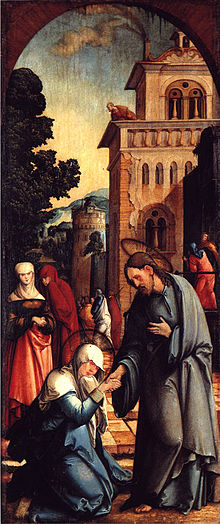- Christ taking leave of his Mother
-
Christ taking leave of his Mother is a subject in Christian art, most commonly found in Northern art of the 15th and 16th centuries. Christ says farewell to his mother Mary, often blessing her, before leaving for his final journey to Jerusalem, which he knows will lead to his Passion and death; indeed this scene marks the beginning of his Passion.[1] In early versions just these two figures are usually shown, at half-length or less.
After Dürer the subject usually has a landscape setting and includes attendants (usually the Three Marys) to Mary, who often swoons with distress and is held by them. Saints Peter, John the Evangelist, Mary Magdalen and other apostles may be shown. It is probably more common in prints than paintings.[2]
Contents
Subject matter
The subject does not illustrate any Biblical passage, but derives from one of the Pseudo-Bonaventura's "Meditations on the life of Christ" (1308), and the Marienleben of Philipp the Carthusian (about 1330).[3] The scene became used in Passion plays and other religious dramas.[4]It may be depicted in Christ Blessing with the Virgin in Prayer, a work by Robert Campin of the early 15th century (Philadelphia),[5] and is painted several times by Gerard David at the end of the century (Dublin, Basel, Munich, Metropolitan New York);[6] many lesser artists were painting the subject by then, especially in Germany.
Awareness of the subject was further spread by prints, by Albrecht Dürer in his very popular woodcut series the on the Life of the Virgin (ca. 1505),[7] and again in his woodcut Passion series (1509), and also by Lucas van Leyden. As was by then often the case, many provincial painters used the compositions of the prints directly as a basis for their paintings, for example a version from his eponymous altarpiece by the Nuremberg painter known as the "Master of the Schwabach Altarpiece"(1506, Compton Verney House), who uses his fellow-townsman Dürer.[8]
The first third of the 16th century was the period of peak popularity for the subject;[9] to the Danube School in particular the opportunities for expressiveness and a landscape background made the subject attractive. Versions include very intense ones by Albrecht Altdorfer,[10] and Wolf Huber (both about 1520 and in the National Gallery, London).[11] The Huber is a cut-down fragment with just the group around the Virgin, and Christ's arm coming in from the right. Both of these works have a lush forest background, and show the female figures in largely contemporary dress.[12]
One of the earliest of the few Italian depictions, an early Correggio of about 1514 (National Gallery, London) clearly (under x-rays) used Dürer's composition as a starting point, before changing it around.[13] Lorenzo Lotto (1521, Gemäldegalerie, Berlin) also painted the subject, and there is a Lucas Cranach the Elder (ca 1520) in Vienna. After 1550 the subject is seen less often, though the Pitti Palace has a work that is at least from the school of Paolo Veronese.
Gallery
-
Bernhard Strigel, 1520, Berlin. Saint Peter heads the disciples waiting for Christ.
-
Lorenzo Lotto 1521, Berlin, with Saint Peter, Saint John and Mary Magdalene.
See also
References
- ^ John Oliver Hand, Catherine A. Metzger, Ron Spronk: Prayers and Portraits: Unfolding the Netherlandish Diptych, p.66, 2006, Yale University Press, ISBN 0300121555
- ^ Langmuir, Erica, The National Gallery companion guide,pp. 102-3. 1997 revised edition, National Gallery, London, ISBN 185709218X
- ^ The National Gallery, Complete Illustrated Catalogue, National Gallery Publications, p.2, 1995, ISBN 185709050
- ^ Langmuir, pp. 102-3.
- ^ Philadelphia Campin image This derives from Byzantine images, according to Hand, Metzer & Spronk op & page cit.
- ^ In a type used for the Munich, Basel and New York examples, a diptych has a half-length Madonna and Child on the left wing, and a Christ taking leave of his Mother on the right wing. MMA, New York - the other wing of this is in England. See Hand, Metzer & Spronk op & page cit., an exhibition catalogue entry for the Basel work.
- ^ Image
- ^ Compton Verney website
- ^ It will be noted that most of the works mentioned here date very close to 1520.
- ^ National Gallery
- ^ National Gallery
- ^ Langmuir, Erica, The National Gallery companion guide, pp. 102-3 and 334-6, 1997 revised edition, National Gallery, London, ISBN 185709218X
- ^ Gould, Cecil, The Sixteenth Century Italian Schools, National Gallery Catalogues, London 1975, ISBN 0947645225
External links
- Italian miniature of ca 1540, with commentary
Categories:- Depictions of the Virgin Mary
- Medieval art
- Renaissance art
- Iconography of Jesus
Wikimedia Foundation. 2010.





